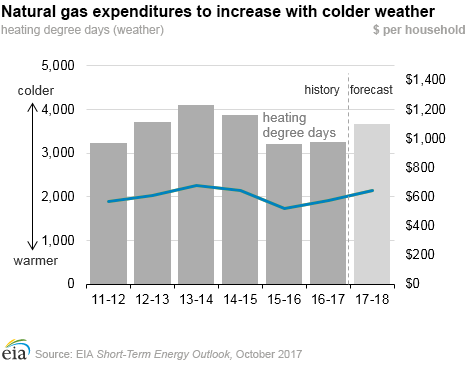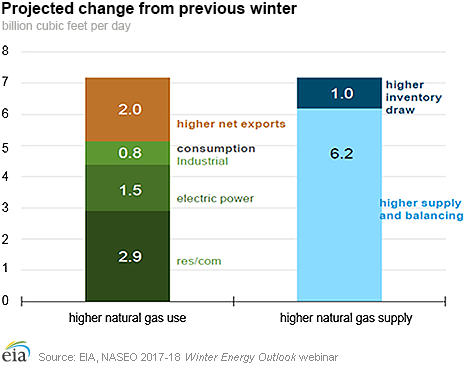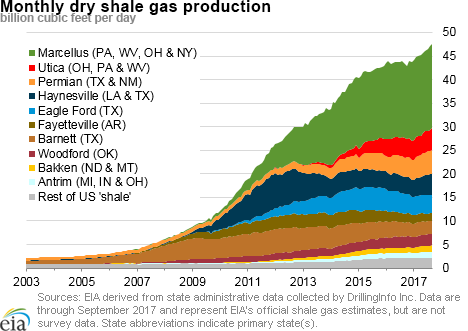In the News:
EIA’s Winter Fuels Outlook projects higher residential natural gas consumption and prices
EIA's Winter Fuels Outlook, released on October 11, 2017, forecasts that households that heat primarily with natural gas will spend $69 (12%) more this winter compared with last winter, largely due to a 9% increase in forecast consumption and a 2% increase in price. The forecast average expenditures of households heating with natural gas are comparable to the previous five-winter average.
EIA forecasts that residential natural gas consumption will average 62 thousand cubic feet (Mcf) per household from October 2017 through March 2018. The increase in consumption compared to last winter is based on a 13% increase in heating degree days, and the forecast return to normal winter temperatures. Winter natural gas prices to residential customers will average $10.36/Mcf, according to the Winter Fuels Outlook. On a per Mcf basis, residential and the Henry Hub price are forecast to increase this winter about the same amount, 18 cents and 16 cents, respectively, from last winter.
Natural gas consumption peaks during the winter season, with nearly half of U.S. homes using natural gas as their primary heating fuel. Compared to last winter, EIA forecasts higher natural gas use and supply. EIA expects increased consumption in all sectors – residential/commercial (higher by 2.9 billion cubic feet per day (Bcf/d)), net exports of both liquefied natural gas and pipeline (2.0 Bcf/d), electric power (1.5 Bcf/d), and industrial (0.8 Bcf/d). This increase in consumption will be offset by 5.8 Bcf/d in production and 1.0 Bcf/d in withdrawals from storage.
EIA projects natural gas inventories will reach 3.8 trillion cubic feet (Tcf) at the end of October, based on expected injection rates. The rate of inventory builds since the start of injection season in April was lower than the five-year average. However, cooler-than-average temperatures in August reduced the use of natural gas for electricity generation and builds for the end of summer were above the five-year average.
EIA's Winter Fuels Outlook, which includes scenarios where temperatures are 10% above and below current forecast levels, is a supplement to EIA's Short-Term Energy Outlook (STEO).
Overview:
(For the Week Ending Wednesday, October 18, 2017)
- Natural gas spot prices were mixed this report week (Wednesday, October 11 to Wednesday, October 18). The Henry Hub spot price fell from $2.93/MMBtu last Wednesday to $2.81/MMBtu yesterday.
- At the New York Mercantile Exchange (Nymex), the November 2017 contract price fell 3¢ from $2.889/MMBtu last Wednesday to $2.854/MMBtu yesterday.
- Net injections to working gas totaled 51 Bcf for the week ending October 13. Working natural gas stocks are 3,646 Bcf, 5% lower than the year-ago level and 1% lower than the five-year (2012–16) average for this week.
- The natural gas plant liquids composite price at Mont Belvieu, Texas, rose by 1¢, averaging $7.93/MMBtu for the week ending October 18. The price of ethane fell by 1%. The price of natural gasoline rose by 2%. The prices of propane, butane, and isobutane were essentially flat.
- According to Baker Hughes, for the week ending Friday, October 13, the natural gas rig count decreased by 2 to 185. The number of oil-directed rigs fell by 5 to 743. The total rig count decreased by 8, and it now stands at 928.
Prices/Supply/Demand:
Prices mixed as a result of cooler temperatures. Temperatures cooled throughout the country this report week, except in the Southwest. This reduced cooling demand along the Gulf Coast and increased home heating demand in the northern states.
This report week (Wednesday, October 11 to Wednesday, October 18), the Henry Hub spot price fell 12¢ from $2.93/MMBtu last Wednesday to $2.81/MMBtu yesterday. At the Chicago Citygate, prices decreased 5¢ to $2.74/MMBtu yesterday.
Prices at PG&E Citygate in Northern California rose 5¢, up from $3.13/MMBtu last Wednesday to $3.18/MMBtu yesterday. The price at SoCal Citygate increased 86¢ from $3.14/MMBtu last Wednesday to $4.00/MMBtu yesterday. The SoCal Citygate price hit an intra-week high of $5.30/MMBtu on Monday, stemming from hot weather in Los Angeles combined with pipeline outages that are hindering natural gas deliveries across California’s southern border.
Northeast prices rise. Temperatures in the Northeast fell, pushing up home heating demand in Boston and New York City. At the Algonquin Citygate, which serves Boston-area consumers, prices went up 40¢ from $2.50/MMBtu last Wednesday to $2.90/MMBtu yesterday. At the Transcontinental Pipeline Zone 6 trading point for New York, prices increased 17¢ from $2.62/MMBtu last Wednesday to $2.79/MMBtu yesterday.
Appalachian prices low as a result of outages. Tennessee Zone 4 Marcellus spot prices increased 1¢ from 80¢/MMBtu last Wednesday to 81¢/MMBtu yesterday. Prices at Dominion South in northwest Pennsylvania rose 9¢ to $1.01/MMBtu yesterday. The price hit a remarkable intra-week low of 32¢/MMBtu last Thursday because of a force majeure on the Texas Eastern Pipeline caused by an unplanned compressor outage in Ohio. This sharply restricted southbound flows of natural gas and caused regional prices to drop temporarily.
Supply is up slightly on elevated production. According to data from PointLogic Energy, the average total supply of natural gas rose by 1% compared with the previous week. Dry natural gas production grew by 2% compared with the previous report week. Average net imports from Canada decreased by 3% from last week.
Overall demand is flat. Total U.S. consumption of natural gas was unchanged from last week, averaging 57.1 Bcf/d, according to data from PointLogic Energy. Decreases in electric sector demand for natural gas this week were offset by increases in demand for home and building heating. Natural gas consumed for power generation declined by 12% week over week, industrial sector consumption increased by 3%, and residential/commercial sector consumption increased by 30%. Natural gas exports to Mexico increased 2%.
U.S. LNG exports decrease. Three vessels (LNG-carrying capacity totaling 11.2 Bcf) departed the Sabine Pass liquefaction facility last week (Thursday to Wednesday), and one vessel (LNG-carrying capacity 3.8 Bcf) was loading at the terminal on Wednesday.
Storage:
Weekly net injections fall short of the five-year average. Net injections into storage totaled 51 Bcf for the week ending October 13, 2017, compared with the five-year (2012–16) average net injection of 78 Bcf and last year's net injections of 77 Bcf during the same week. Increased power demand for natural gas contributed to decreased net injections compared with the previous report week. Net injections into storage were lower than the five-year average in all regions except the East region and Midwest region. The South Central region accounted for most of the shortfall compared with the five-year average for the week, with net injections totaling 1 Bcf, or 29 Bcf lower than the five-year average net injection. Working gas stocks total 3,646 Bcf, or 35 Bcf less than the five-year average and 179 Bcf less than last year at this time.
Working gas stocks are poised to end the refill season lower than the five-year average. So far during the 2017 refill season, net injections into storage are 16% lower than the comparable five-year average—1,595 Bcf during the 2017 refill season compared with the five-year average increase of 1,895 Bcf. If net injections continue at 16% lower than the five-year average for the remaining three weeks, working gas stocks will reach 3,781 Bcf by the end of the refill season. Working gas stocks will total 3,807 Bcf if net injections into working gas match the five-year average for the remainder of the refill season.
The January 2018 futures price continues trading at a premium over the current spot price. During the most recent storage week, the average natural gas spot price at the Henry Hub was $2.90/MMBtu, while the Nymex futures price of natural gas for delivery in January 2018 averaged $3.19/MMBtu, a difference (premium) of 28¢. The premium was 44¢ a year ago. The average natural gas spot price at the Henry Hub was 1¢ higher than the front-month futures price at the Nymex. A year ago, the spot price was 11¢ lower than the front-month contract.
The reported net implied flows into storage are close to analysts’ expectations, and trading on the Nymex at the release of the WNGSR was elevated. According to the Desk survey of natural gas analysts, estimates of net injections into working natural gas storage ranged from 42 Bcf to 64 Bcf with a median of 51 Bcf. Prices for the futures contract for November delivery fell about 2¢/MMBtu to $2.84/MMBtu with 1,657 contracts traded at the release of the Weekly Natural Gas Storage Report (WNGSR). Prices remained close to that level in subsequent trading.
Temperatures are higher than normal in most regions. Temperatures in the Lower 48 states averaged 66 degrees Fahrenheit (°F), 7°F higher than the normal and 2°F higher than last year at this time. The Mountain Census division was the only region reporting cooler-than-normal temperatures, averaging 55°F, or 2°F lower than the normal and 3°F lower than last year at this time.
See also:
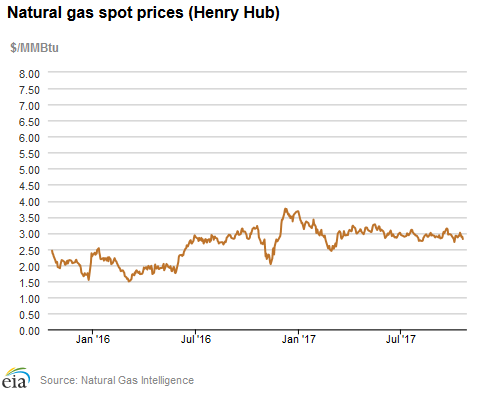
| Spot Prices ($/MMBtu) | Thu, 12-Oct |
Fri, 13-Oct |
Mon, 16-Oct |
Tue, 17-Oct |
Wed, 18-Oct |
|---|---|---|---|---|---|
| Henry Hub |
2.91 |
3.01 |
2.87 |
2.89 |
2.81 |
| New York |
2.20 |
1.30 |
2.85 |
2.79 |
2.79 |
| Chicago |
2.76 |
2.78 |
2.81 |
2.79 |
2.74 |
| Cal. Comp. Avg.* |
2.83 |
2.84 |
2.94 |
2.98 |
2.85 |
| Futures ($/MMBtu) | |||||
| November Contract | 2.989 |
3.000 |
2.946 |
2.962 |
2.854 |
| December Contract |
3.144 |
3.160 |
3.108 |
3.128 |
3.065 |
| *Avg. of NGI's reported prices for: Malin, PG&E Citygate, and Southern California Border Avg. | |||||
| Source: NGI's Daily Gas Price Index | |||||
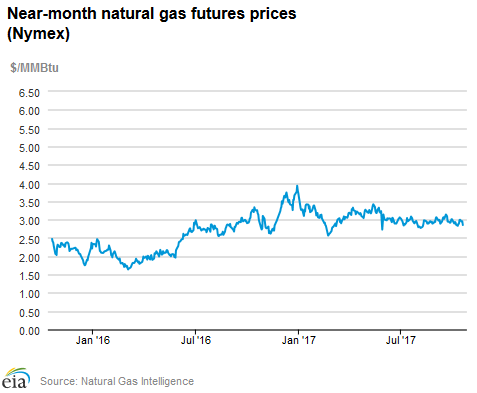
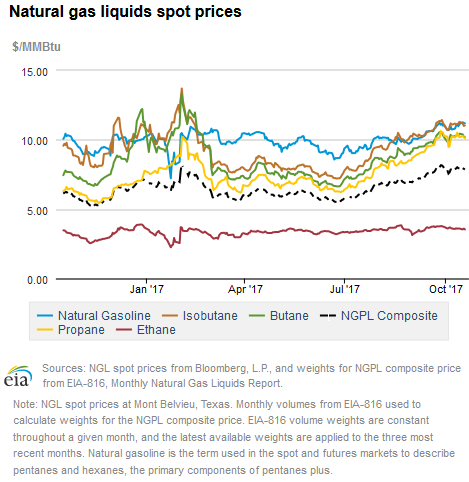
| U.S. natural gas supply - Gas Week: (10/12/17 - 10/19/17) | |||
|---|---|---|---|
Average daily values (Bcf/d): |
|||
this week |
last week |
last year |
|
| Marketed production | 82.2 |
80.8 |
78.8 |
| Dry production | 73.7 |
72.4 |
70.2 |
| Net Canada imports | 5.7 |
5.9 |
5.3 |
| LNG pipeline deliveries | 0.0 |
0.0 |
0.1 |
| Total supply | 79.4 |
78.4 |
75.6 |
|
Source: OPIS PointLogic Energy, an IHS Company | |||
| U.S. natural gas consumption - Gas Week: (10/12/17 - 10/19/17) | |||
|---|---|---|---|
Average daily values (Bcf/d): |
|||
this week |
last week |
last year |
|
| U.S. consumption | 57.1 |
57.2 |
55.4 |
| Power | 25.4 |
28.7 |
24.3 |
| Industrial | 20.0 |
19.4 |
19.5 |
| Residential/commercial | 11.7 |
9.0 |
11.5 |
| Mexico exports | 4.3 |
4.2 |
4.2 |
| Pipeline fuel use/losses | 6.3 |
6.3 |
6.1 |
| LNG pipeline receipts | 3.0 |
2.8 |
0.0 |
| Total demand | 70.6 |
70.4 |
65.6 |
|
Source: OPIS PointLogic Energy, an IHS Company | |||
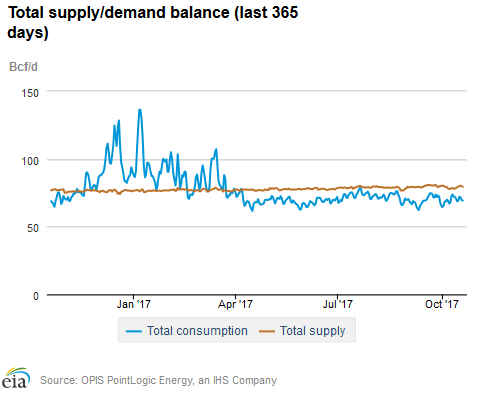
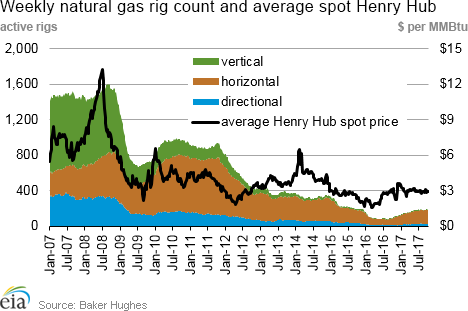
| Rigs | |||
|---|---|---|---|
Fri, October 13, 2017 |
Change from |
||
last week |
last year |
||
| Oil rigs | 743 |
-0.7% |
72.0% |
| Natural gas rigs | 185 |
-1.1% |
76.2% |
| Note: Excludes any miscellaneous rigs | |||
| Rig numbers by type | |||
|---|---|---|---|
Fri, October 13, 2017 |
Change from |
||
last week |
last year |
||
| Vertical | 63 |
-3.1% |
10.5% |
| Horizontal | 786 |
-0.8% |
82.4% |
| Directional | 79 |
0.0% |
54.9% |
| Source: Baker Hughes Inc. | |||
| Working gas in underground storage | ||||
|---|---|---|---|---|
Stocks billion cubic feet (Bcf) |
||||
| Region | 2017-10-13 |
2017-10-06 |
change |
|
| East | 902 |
884 |
18 |
|
| Midwest | 1,054 |
1,024 |
30 |
|
| Mountain | 224 |
223 |
1 |
|
| Pacific | 316 |
315 |
1 |
|
| South Central | 1,150 |
1,149 |
1 |
|
| Total | 3,646 |
3,595 |
51 |
|
| Source: U.S. Energy Information Administration | ||||
| Working gas in underground storage | |||||
|---|---|---|---|---|---|
Historical comparisons |
|||||
Year ago (10/13/16) |
5-year average (2012-2016) |
||||
| Region | Stocks (Bcf) |
% change |
Stocks (Bcf) |
% change |
|
| East | 923 |
-2.3 |
897 |
0.6 |
|
| Midwest | 1,090 |
-3.3 |
1,042 |
1.2 |
|
| Mountain | 243 |
-7.8 |
213 |
5.2 |
|
| Pacific | 325 |
-2.8 |
352 |
-10.2 |
|
| South Central | 1,245 |
-7.6 |
1,177 |
-2.3 |
|
| Total | 3,825 |
-4.7 |
3,681 |
-1.0 |
|
| Source: U.S. Energy Information Administration | |||||
| Temperature – heating & cooling degree days (week ending Oct 12) | ||||||||
|---|---|---|---|---|---|---|---|---|
HDD deviation from: |
CDD deviation from: |
|||||||
| Region | HDD Current |
normal |
last year |
CDD Current |
normal |
last year |
||
| New England | 20 |
-66 |
-12 |
12 |
12 |
12 |
||
| Middle Atlantic | 9 |
-65 |
-30 |
25 |
23 |
25 |
||
| E N Central | 31 |
-47 |
-1 |
10 |
7 |
0 |
||
| W N Central | 69 |
-6 |
13 |
6 |
2 |
2 |
||
| South Atlantic | 1 |
-36 |
-11 |
81 |
48 |
35 |
||
| E S Central | 4 |
-33 |
-4 |
54 |
37 |
15 |
||
| W S Central | 8 |
-3 |
5 |
62 |
23 |
-2 |
||
| Mountain | 86 |
12 |
23 |
14 |
-3 |
-2 |
||
| Pacific | 20 |
-6 |
8 |
10 |
-2 |
-6 |
||
| United States | 26 |
-29 |
-2 |
34 |
18 |
10 |
||
|
Note: HDD = heating degree day; CDD = cooling degree day Source: National Oceanic and Atmospheric Administration | ||||||||
Average temperature (°F)
7-Day Mean ending Oct 12, 2017
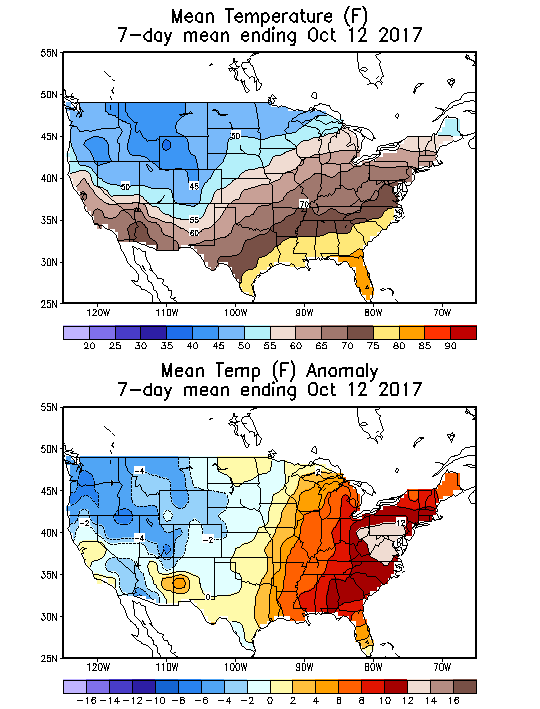
Source: NOAA National Weather Service
Deviation between average and normal (°F)
7-Day Mean ending Oct 12, 2017

Source: NOAA National Weather Service

